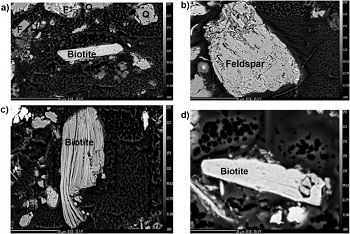Lybrand & Rasmussen, 2018
Climate, topography, and dust influences on the mineral and geochemical evolution of granitic soils in southern Arizona
Lybrand R.A. and Rasmussen C. (2018)
Geoderma 314: 245-261
-
Calhoun, Catalina-Jemez, COLLABORATOR
-
Catalina-Jemez, INVESTIGATOR
Plain English Summary
- Climate, topography, and dust control evolution of granitic soils in southern Arizona.
- Mineral weathering was greatest in downslope, convergent positions of conifer system.
- Soils were enriched in Fe + Mg and feldspars, suggesting deposition of dust to sites.
- Dust comprises up to ~ 20% of mineral material in desert and conifer soils.
- We document weathered biotite, feldspar, and minor amount of quartz in desert dust.
Abstract
Backscattered electron images of transformed grains in dust samples collected at the desert scrub site. In the images, F denotes feldspar and Q signifies quartz.
Mineral weathering transforms rock into soils that supply nutrients to ecosystems, store terrestrial carbon, and provide habitat for organisms. As a result, the mineralogy and geochemistry of soils from contrasting environments are well-studied. The primary objective of this research was to examine how climate, topography, and dust interactively control the mineral and geochemical composition of granitic soils that span an environmental gradient in southern Arizona. Two field sites were selected within the Catalina Critical Zone Observatory that exhibit significant range in precipitation (25 to 85 cm yr− 1), temperature (24 to 10 °C), and vegetation composition (desert scrub → mixed conifer). Within each site, two catena end member pairs were selected to represent variation in local topography which included divergent, water-shedding summits and convergent, water-gathering footslopes. Soils and parent rock were studied using x-ray diffraction and x-ray fluorescence. Dust samples were collected from ridgetop dust traps at the desert scrub site and examined using x-ray fluorescence. The desert scrub soils showed enrichment in biotite, total feldspar, and Fe + Mg whereas the mixed conifer soils were depleted in feldspars and enriched in Fe + Mg. Depletions of Na, Si, and K + Ca occurred in both the desert and mixed conifer ecosystems, with the convergent soils in the conifer sites exhibiting the greatest degree of elemental loss. We examined dust in the regolith after identifying mineral and elemental enrichments in both ecosystems. Dust fraction estimates ranged from 2 to 21% in desert soils and 9 to 19% for the mixed conifer soils. Our results confirm the interactive role of bioclimate, topography, and dust in driving the geochemical evolution of soils and cycling of nutrients in desert and conifer ecosystems.
Citation
Lybrand R.A. and Rasmussen C. (2018): Climate, topography, and dust influences on the mineral and geochemical evolution of granitic soils in southern Arizona. Geoderma 314: 245-261. DOI: 10.1016/j.geoderma.2017.10.042
 This Paper/Book acknowledges NSF CZO grant support.
This Paper/Book acknowledges NSF CZO grant support.
Explore Further



